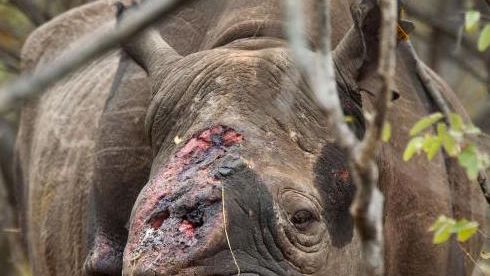

The fate of the rhino: the photographs that make you question humanity
Words: Hamish Roy
This article contains graphic images
Since 2014, a taupe-coloured powder has been trading hands on the black market for upwards of $60,000 a kilo – a higher price, weight for weight, than heroin or cocaine. Like these, it is billed as a drug, its would-be medicinal properties ranging from the curing of gout to the alleviation of nausea. Yet powdered rhino horn is inert; it is, after all, a rough equivalent to a human fingernail.
A de-horned rhino is found dead on a game reserve in Mugie, Kenya. Image: Mugieranch.wordpress
Ivory, the ‘white gold’ of the black market, currently trades for around $2,000 per kilo, a marked decrease in price that suggests a dwindling demand. The trade in rhino horn, on the other hand, is now so lucrative that poachers are willing to risk death to obtain it. A brutish, bloody and dangerous business, rhino poaching has become a bone-fide armed conflict. Bristling with weapons, the poachers are pitted against the rangers. For the people involved, it’s a nasty business; for the rhino, it is catastrophic.
A badly wounded rhino receives treatment. Perhaps the greatest risk to poaching survivors is their vulnerability to infection. Image: Earthtouchnews.com
The continuing demand for rhino horn stems primarily from its use in various forms of traditional medicine. It remains particularly popular in China, where people have for centuries believed in its ameliorative effects. Demand is likewise high in Vietnam, still stoked by rumours of rhino horn’s cancer-curing abilities. Sadly, such superstition has proven deadly. In 2010, Vietnamese authorities came across the carcass of a Javan rhino with a bullet in its leg and its horn sawn off. It was in fact the very last of its kin: Vietnam has since declared its Javan rhino population extinct.
Esteemed wildlife photographer David Yarrow sits with a gravely wounded rhino. Image: David Yarrow
While conservation efforts are increasing by the year, the situation seems to be approaching a crisis point. The rhino has walked the earth for around 40 million years, and at the beginning of the 20th century, there were at least 500,000 rhinos remaining on the African and Asian continents. Today, there are only 29,000 rhinos left worldwide, with 1,338 poached last year in Africa alone.
Nkwe wildlife security services stage a mock arrest in advance of an operation. Image: Zute Lightfoot
One species, the northern white rhino, is teetering on the very edge of the void. Sudan, who lives on Kenya’s Old Pejeta reserve, is the last male of his entire species. A last, lonely emblem of a destructive trade, he receives round-the-clock protection from a dedicated team of armed security services. His age, however, makes the likelihood of successful mating exceedingly slim, meaning there is a good chance that the northern white will vanish from the wild altogether.
Sudan, the last male northern white rhino, receives round-the-clock armed protection on the Old Pejeta reserve in Kenya. Image: Bret Stirton/National Geographic
Both African and Asian rhinos are being consumed – quite literally – as a byproduct of human greed and superstition. Removing their horns may have some effect on deterring poachers, but while the consumer remains willing to sacrifice a rhino for illusory beliefs, the poachers will still kill a rhino in order to dig out the remaining stump. At the very root of the problem is is our attitude to the natural world, and it is this that must be addressed. Failing this, species like the northern white may soon become confined to the pages of our not-so-natural history books.
As nature intended: David Yarrow captures a black rhino in all its majesty. Image: David Yarrow
To find out more, visit www.savetherhino.org


